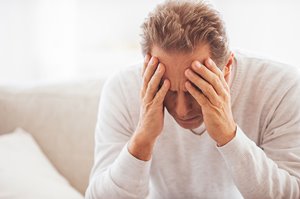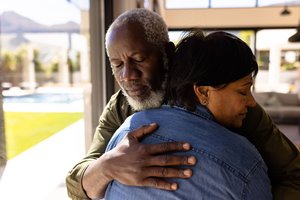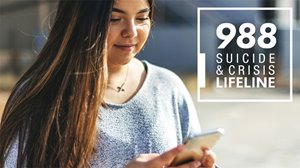 September is National Suicide Prevention Awareness month. It is a time when communities can share resources and connect with one another to increase knowledge and awareness about suicide with the goal of preventing future suicides and supporting friends and loved ones struggling with mental illness.
September is National Suicide Prevention Awareness month. It is a time when communities can share resources and connect with one another to increase knowledge and awareness about suicide with the goal of preventing future suicides and supporting friends and loved ones struggling with mental illness.
According to the Centers for Disease Control and Prevention (CDC), 45,979 lives ended in death by suicide in 2020—an average of 1 death every 11 minutes. That same year, suicide was the 12th leading cause of death in the United States, and occurred at nearly twice the rate of homicides, as reported by the National Institutes of Mental Health (NIMH). However, not all suicide attempts result in death, and these statics point to an even more wide-spread national mental health issue. For example, the CDC found that in 2020, for every suicide death, there were:
- 4 hospitalizations for every suicide attempt
- 8 emergency department visits related to suicide
- 27 Self-reported suicide attempts
- 275 people who seriously consider suicide
Looking at the larger, nationwide picture, those numbers translate to 12.2 million adults who seriously considered suicide, 1.2 million adults who attmpted suicide, and “nearly $490 billion in medical costs, work loss costs, value of statistical life, and quality of life costs,” in a single year.
Barriers to effective treatment—stigma
 Suicide affects everyone regardless of age, class, race or gender identity, and yet, despite its pervasiveness, there is still a good deal of stigma attached to suicide. Stigma is defined as “a mark of disgrace associated with a particular circumstance, quality, or person,” and is perhaps the most common reason that people with a mental illness or suicidal thoughts avoid or don’t receive treatment. Examples of harmful stigma (or beliefs) that are attached to suicide include: “everyone who dies by suicide is depressed,” “just asking someone about suicide may plant the idea in their mind,” and “suicidal people want to die.”
Suicide affects everyone regardless of age, class, race or gender identity, and yet, despite its pervasiveness, there is still a good deal of stigma attached to suicide. Stigma is defined as “a mark of disgrace associated with a particular circumstance, quality, or person,” and is perhaps the most common reason that people with a mental illness or suicidal thoughts avoid or don’t receive treatment. Examples of harmful stigma (or beliefs) that are attached to suicide include: “everyone who dies by suicide is depressed,” “just asking someone about suicide may plant the idea in their mind,” and “suicidal people want to die.”
These negative stereotypes and characterizations, and the beliefs that often accompany mental illness—that the illness is a sign of weakness, or that it is a personal failing or character flaw—often run deep in society (and sometimes in individuals with the illness) and present some of the biggest barriers to getting effective treatment. And, the same negative attitudes that are attached to people suffering with mental illness or suicidal ideation frequently result in discrimination, isolation, and shame.
However, the truth is that mental illness is just that—an illness. As a society, we don’t say to someone with cancer, diabetes or multiple sclerosis that their disease is a personal failing or a sign of weakness. Instead, we do everything we can to cure or alleviate the symptoms of the disease. And, like any other disease that affects the body, mental illness is treatable, usually with a combination of medication and therapy.
Who’s at risk?
The CDC notes that “suicide is rarely caused by a single circumstance or event,” but rather by a combination of different factors, and divides these suicide risk factors into four categories.
Individual—or personal—risk factors include: a previous suicide attempt, a history of depression and other mental illnesses, a sense of hopelessness, criminal or legal problems, job or financial problems, substance misuse, and violence victimization and/or perpetration.
-
Relationship risk factors include: bullying, a family history of suicide, loss of relationships, a high conflict or violent relationship, social isolation.
-
Community risk factors include: lack of access to healthcare, community violence, historical trauma and discrimination of any type (for example, sexual, racial, or age-based discrimination).
-
Societal risk factors include: the stigma associated mental illness and seaking help, easy access to lethal means of suicide among people at risk (for example, guns or prescription medications), and unsafe media portrayals of suicide.
Protective factors
 Just as certain circumstances and events can increase a person’s risk of developing a mental illness or suicidal thoughts, other circumstances and events can decrease that risk. The CDC points to similar protective factors that can balance out, or mitigate, the aforementioned circumstances and events that increase suicide risk.
Just as certain circumstances and events can increase a person’s risk of developing a mental illness or suicidal thoughts, other circumstances and events can decrease that risk. The CDC points to similar protective factors that can balance out, or mitigate, the aforementioned circumstances and events that increase suicide risk.
- Personal factors that protect against suicide risk include: effective coping and problem-solving skills; reasons for living—for example, family, friends, pets, etc.; a strong sense of cultural identity.
- Healthy relationship experiences that protect against suicide risk include: support from partners, friends, and family; feeling connected to others.
- Supportive community experiences that protect against suicide risk include: feeling connected to school, community, and other social institutions; availability of consistent and high quality physical and behavioral healthcare.
- Cultural and environmental factors within the larger society that protect against suicide risk include: reduced access to lethal means of suicide among people at risk; cultural, religious, or moral objections to suicide.
Warning signs
Suicidal ideation and suicide risk is not “one size fits all”—rather, each individual will present with different symptoms. Additionally, realizing that someone might be at risk for attempting suicide can be difficult, as the signs of an increased suicide risk are often subtle. Nevertheless, there are common warning signs, which include:
- Talking about being a burden
- Being isolated
- Increased anxiety
- Talking about feeling trapped or in unbearable pain
- Increased substance use
- Looking for a way to access lethal means
- Increased anger or rage
- Extreme mood swings
- Expressing hopelessness
- Sleeping too little or too much
- Talking or posting about wanting to die
It is important to remember that talking to someone about how they are feeling and asking whether they’re having thoughts of suicide will NOT plant the idea in their mind. On the contrary, talking to someone about how they are feeling is a very effective way to prevent a suicide attempt.
Suicide prevention resources
 Suicide is a serious public health problem that can have long-lasting effects on individuals, families, and communities. If you, or anyone you know, are experiencing any of the symptoms above, there is help. Calling or texting 988—the National Suicide & Crisis Lifeline—will connect anyone experiencing thoughts of suicide, a mental health concern, substance use issue, or any other emotional distress to a trained crisis counselor.
Suicide is a serious public health problem that can have long-lasting effects on individuals, families, and communities. If you, or anyone you know, are experiencing any of the symptoms above, there is help. Calling or texting 988—the National Suicide & Crisis Lifeline—will connect anyone experiencing thoughts of suicide, a mental health concern, substance use issue, or any other emotional distress to a trained crisis counselor.
Additionally, HOPELINE, the text service with a network of 2,600 trained counselors across the state of Wisconsin, will continue to help those in crisis. To access HOPELINE, type 741741 in the “To” section of your phone’s text screen, type “HOPELINE” in the message area, then click “Send.”
In Door County, additional sources of information include your own Employee Assistance Program, accessed through your employer, or the Community Resources tab on the Door County Library website. If it’s an emergency, calling 9-1-1 or going directly to the hospital emergency room are the best options to avoid a tragedy.